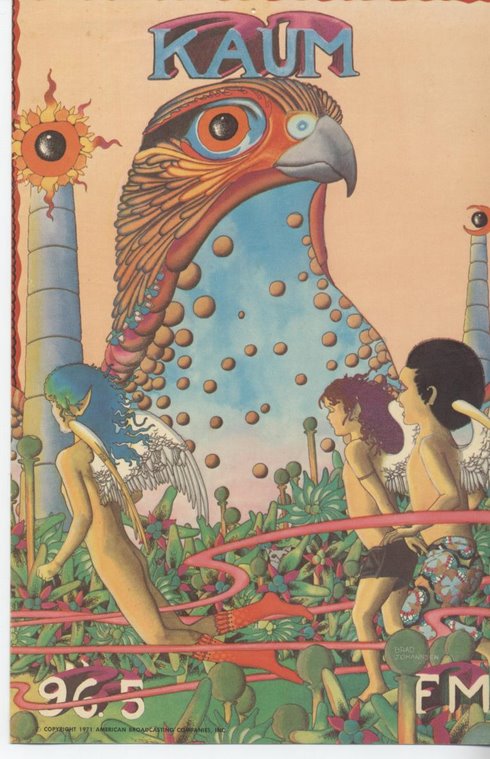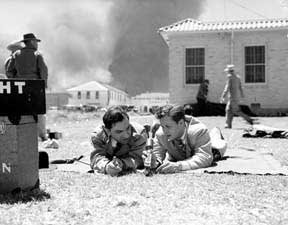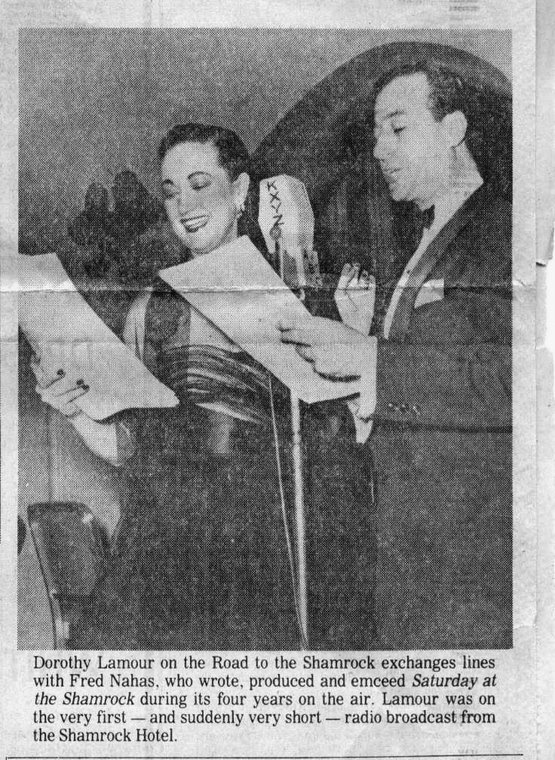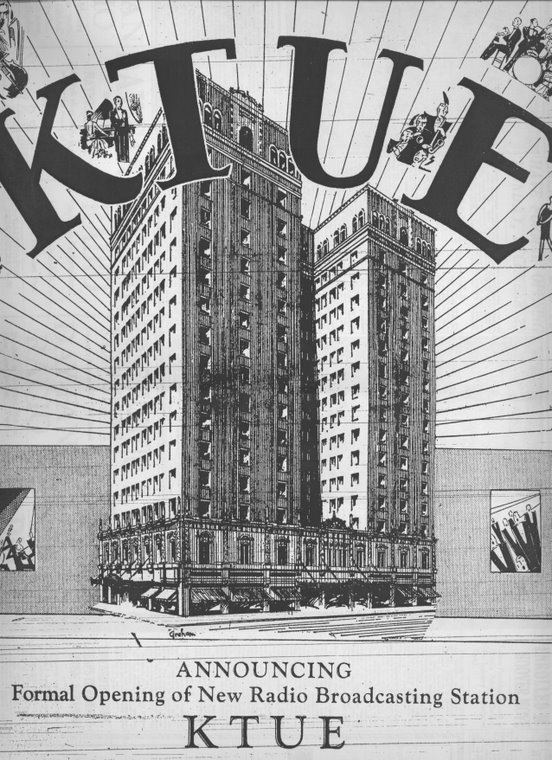1922 Part 1 - March - WEV

On March 23, 1922, the first license for a Houston broadcast station was issued by the Commerce Department, Bureau of Navigation, to the Hurlburt-Still Electrical Co. located at McKinney Ave. at San Jacinto St. where the company had a garage to service automobile batteries. The call letters assigned were WEV. It was the 4th broadcasting station authorized in Texas and 108th nationwide; there were estimated to be about 300 receiving sets in Houston at the time. The station was listed as an active station on the Commerce Department official lists about two and a half years broadcasting ‘music and speeches and other entertainments’ on 360 meters (833 kilocycles/kilohertz) and weather and market reports on 485 meters (619 kilocycles/kilohertz), the two frequencies set aside by the Commerce Department for broadcasting, sharing time on those two frequencies with all other stations in Houston and Galveston and the whole country for the first year.
A note on meters, kilocycles, kilohertz, megacycles and megahertz....
At first, radio frequencies were described in meters, which referrred to the length of the radio waves. Then, the term kilocycles became common, abbreviated kc; this stood for kilocycles per second, a measure of the frequency of the signal. The Commerce Department adopted the term kilocycles in 1923 but as late as the 1940s radio listings in the Houston papers still included meters for the convenience of Houstonians with older sets.
In 1960 it was officially decided that the term Hertz would be substituted for cycles, after the German physicist Heinrich Rudolf Hertz who had discovered radio waves. It was 1970 before the term kilohertz, abbreviated kHz, became common, however. The same thing happened to the term megacycles as applied to FM frequencies. For this chronology, I have used the terms ‘meters’ and ‘kilocycles,’ or ‘kc’ for the earliest years, then ‘kilocycles,’ ‘kc,’ ‘megacycles,’ or ‘mc’ through about 1965. Thereafter, the terms ‘kilohertz’and ‘megahertz’ are used, although sparingly, because they become so repetitive; frequently, just a number is given for a station’s frequency as this is common usage now. For more on meters and kilocycles and how to convert one to the other, go here..
The first notice of the new station came on Saturday April 15 on page 2 of the Houston Press under the headline ‘Houston Radio Broadcasts Storm Warning.’ The paper said Hurlburt-Still’s station was the most powerful one south of Kansas City, with 200 watts, allowing a coverage of 1000 to 1200 miles.
A brief story Sunday April 16 in the Automobile News Section of the Houston Chronicle added that the service had begun on April 12. The Chronicle story seemed to have originated with Dr. B. Bunnemeyer, a local weather forecaster.
More information was reported in a story April 18, 1922, on page 4 of the Post under the heading “Houston Firm is Granted Official Radio License”:
"To the Hurlburt-Still Electrical company comes the honor of being granted the first official radio telephone broadcasting station license in Houston. This license has been granted by the department of commerce (sic) at Washington and the station now is in operation.
Official United States weather bulletins are being sent broadcast by radio telephone from Houston daily. The morning bulletin is sent out at 10 o’clock and the later bulletins are reported and sent out at at 5:30pm The wave length used in this broadcasting work is 485 meters.
Storm and flood warnings also will be transmitted by the Houston station. Road conditions, crop and market reports and other government information sent out (sic).
In addition to the government information concerts and other entertainments will be sent out over a wave length of 360 meters.
The inability to obtain necessary apparatus has forced the station to operate on a slightly reduced power but when fully completed it will have a 500-Watt power. This power will enable receiving sets 1500 miles from the city to pick up the messages."
The government considered the broadcasting of weather, crop and market information the most important service to be offered by broadcasters. Besides the Bureau of Navigation, the Agriculture Department was the major force behind the government’s regulation of wireless. The Agriculture Department wanted the service on 485 meters for the benefit of farmers, who were having to rely on newspapers delivered by mail for this kind of information, which wasn’t very satisfactory. All information transmitted had to come from official government sources. The 485 meter wavelength was more desirable because of superior groundwave propagation and there were to be only 2 licensees in each city authorized to operate on that frequency, to lessen the problems of interference. Obtaining one of those allotments was much more difficult than getting a license to operate on 360 meters.
Most broadcasters and most of the listening public were probably more interested in the entertainment programming sent out on 360 meters. From the newspaper notices it’s not clear if WEV was operating yet on 360 meters as of April 18 but that had certainly changed by May 11 and probably before then. The Post reported on page 8 of the Friday, May 12, edition that the Lane and Bowler, 6th and Gerard Streets, industrial band, which had been furnishing the music for a revival, had stopped by the Hurlburt-Still Electrical Company’s broadcasting station and rendered several selections for ‘local radio fans’ the previous evening.
"Repeated telephone requests for solos from the band brought out the soloists and a novelty in this connection was introduced by Tony Pecoraro who played for the fans ‘Il Trovatore’ and ‘Beautiful Ohio’ on the harmonica..... The concert sent out Thursday night was sent out on a wave length of 360 meters and according to Mr. Still could have been heard in Chicago providing weather conditions were clear."
Some of the people in attendance went across the street to the Joe Hornberger residence to listen on his ‘splendid station,’ thus participating in both the broadcast and reception of the program. Mr. Hornberger had a powerful receiving station and had reported hearing concerts from the Hawaiian Islands stations, Long Island, Rome, Italy and Bordeaux, France. Receiving sets were called ‘radio stations,’ too.
It’s apparent from this report this was not the first broadcast of entertainment programming on 360 meters.
Among the milestones achieved by WEV during the time it was an active station: on the 22nd of June the station broadcast what the Houston Post declared to be the first ever radio recital in Texas. Two hundred and fifty pupils of Mrs. John Wesley Graham crowded into a makeshift auditorium at the Hurlburt-Still garage as a mass choir; 50 soloists were featured. Besides that an adult glee club and the Graham Four, a female quartet, performed and there was room for some audience, too.
"Flowers of every color were banked about the platform among large pots of ferns and palms and made a most attractive frame for the picture formed by the pretty young maidens dressed in their bright colored evening gowns."
The second half of the student body was due to perform the following week while Mrs. Graham was to be a fixture on the Houston airwaves for over 2 decades.
Seven months later, in early January, 1923, the station broadcast an informal retrospective, featuring the most popular performers who had appeared in the first 10 months of the station’s existence, a sort of ‘greatest hits of 1922 year end review.’
WEV was to participate in what was perhaps the first ‘statewide’ broadcast on February 1, 1923, on the 78th anniversary of Baylor University. State officials, including Governor James Neff, had used the facilities of the University of Texas station at Austin, WCM, to communicate ‘statewide’ before, notably after devasting rains and floods that affected a large portion of the state in the spring of 1922, but coverage was subject to atmospheric conditions. For the special Baylor broadcast, stations in Waco (WJAD later WACO), Fort Worth (WBAP), Dallas (WFAA) and Houston (WEV) would coordinate segments of an hour long program, with each station originating a portion. Baylor alum Judge Lewis R. Bryan would speak from WEV. The program concluded with a 20 minute band concert and pep demonstration by students in Waco. The Baylor University club of Houston would be having its annual banquet at the University Club and would listen in. There was no explanation in the Houston Post account of the technical details of the coordinated broadcast. There was no mention of interconnectivity but every station would have been operating on 360 meters, or as close to it as they could maintain their equipment, so presumably each station would power up only for their segment of the program and then go off so that the stations from elsewhere could be heard locally.
For the operators of a garage with no apparent experience in the field of entertainment, the Hurlburt-Still Co. did a good job as Houston’s first broadcast station licensee. Regulations prohibited the use of any mechanically reproduced entertainment, such as player pianos or Victrolas, all the entertainment presented had to be performed live. Even for the few hours a week each station broadcast, arranging for all that must have been a time-consuming job. WEV was officially deleted from the Commerce Department lists on January 10, 1925, but just why it went silent is not known at this time. For more on Houston’s first broadcasting station and the company which owned it, including a picture of the station and more on their early programming, advertising and promotions, will be posted soon.
The first image above is from the archives of the Houston Post at the Houston Public Library. That is the WEV facility at the corner of McKinney and San Jacinto in downtown Houston. For more information on the picture, see the WEV station profile.
The second image, from the archives of the Houston Chronicle at the Houston Public Library, is of a WEV ad in the Chronicle in July, 1922. The Chronicle was running a promotion titled "Let's all Listen in On the Radio" which actually involved decoding messages included in each advertiser's ad in the paper, not listening in on the radio.










No comments:
Post a Comment